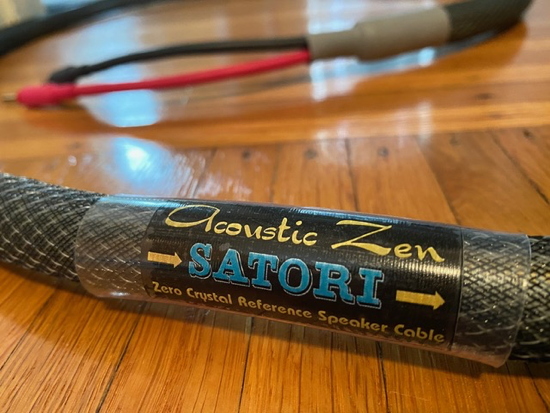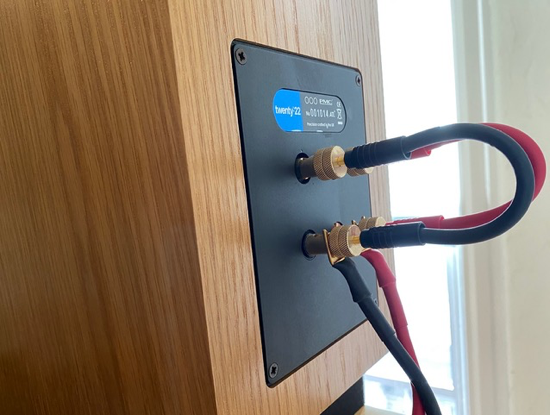
Many facets of cable design can rapidly overwhelm you while shopping for a pair of audiophile speaker cables. Copper, silver, oxygen-free, continuous-cast, dielectric, solid-core, solderless, cold-welded, wire geometry and the list goes on. Robert Lee, the founder of Acoustic Zen Technologies, has been skillfully utilizing these elements in his cable designs for the past 20 years.
About the Acoustic Zen Satori Cables
The Acoustic Zen Satori cables ($798/8’ pair) are the second tier of Acoustic Zen’s range of speaker cables. They reside one step above the company’s entry-level Epoch series. They’re constructed with multiple strands of incrementally layered, non-extruded 10 gauge zero-crystal copper. Zero-crystal means that the surface of the copper conductor is perfectly smooth and seamless. There are no boundaries or barriers that act as a form of resistance to the flow of electric current.
I connected these thick garden-hose like Satori cables to the lower binding posts of my reference PMC twenty.22 speakers, linking the lower and upper posts with the matching Satori Jumper Cables ($140/set). I connected the other end to my Sony TA-A1ES integrated amplifier. My sources were Tidal and Qobuz from the Lumin U1 Mini streaming transport, connected via USB to the Marantz SA-KI Ruby DAC.
Before I continue, I think it’s worth mentioning that these cables were not provided to me as a review sample by Acoustic Zen, nor did I purchase them from a dealer. They were a gift from a friend who had recently upgraded his system. Therefore, I went into this experience without any buyer’s remorse due to monetary expenditure or preconceived notions about their performance. I had no expectations about how these cables were “supposed” to sound.
Performance and Sound Quality

I was skeptical about whether I would be able to hear any real difference in my system’s sound quality after hooking up these cables. Would the differences be so slight that it would be impossible to write anything meaningful about the experience? After playing only a few songs I realized that my skepticism was unwarranted.
The Satori cables highlighted low-level micro details. Every element inside the music was clear and easy to discern. There was a smoothness that seemed to have an effect on the rhythmic timing and flow. On songs with a heavy and aggressive driving drum beat, there was now a sense of ease and clarity. This smooth character made for a fatigue-free listening experience that was lush, vivid, and involving.
Beyond the soundstage’s expanded width, emerged an immediately noticeable depth. I loved the music’s locked-in focus in the area between the speakers, while other elements seemed to dramatically arc vertically, wrapping around my head from above. When I experienced these three-dimensional cues, I began to understand the experience that Acoustic Zen had engineered into these cables.
Tonally, the high frequencies were slightly tamed while the bass was clean and nimble. The outstanding highlight was the clarity and focus of the midrange. It’s as if I was holding an audio magnifying glass over the midrange, bringing into focus new detail and nuance.
Standout Recordings
As I spent more time listening with the Satori cables, I suddenly realized that I was hearing some of the same performance characteristics that I’ve previously only heard inside high-end rooms at audio shows.
There were a few specific examples of songs that admirably demonstrated the attributes and strengths of the Satori cables. The first song was “Mercy Street” by Peter Gabriel. Admittedly, the production value on this song is top-notch, but what surprised me was that I could now hear how the mastering engineer had layered Peter’s own voice at different pitches on top of itself. I’ve listened to this song countless times, and this was the first time I’ve been able to hear these intricate details in his voice.
Second, was the song “Anoranza (Yearning)” from Strunz & Farah. This recording isn’t nearly as pristine, and it has some noticeable background hiss. However, what struck me is how beautiful and organic the acoustic guitars sounded. The tonal structure was faithfully preserved and when I closed my eyes I could visualize them playing ten feet in front of me. This level of intimacy transported me to the recording session and gave me a new appreciation for this arresting musical composition.
True to their namesake, these cables seemed to excel with well-recorded acoustic instruments and vocals. With some of my electronic music test tracks, the rhythmic pace sounded slightly sluggish and lacked the forward momentum and drive I am accustomed to.
Conclusion and Value
The Acoustic Zen Satori cables provided additional insight into the music. Their high performance dictates that they should be treated as another component in your system. This means careful consideration when matching them with the rest of your components. Fortunately, most retailers offer a 30-day trial period, so it’s a low-risk high-reward situation.
In summary, the Satori speaker and jumper cables elevated the performance of my entire system. They’re worth $938, and I encourage you to try them in your own system.


I recently acquired a pair of Satori bi wire cables, used, on US audiomart and love them. These may be even better than the the single versions you have recently reviewed, though I have not heard them. These are 4 separate cables, plus and minus for low pass and high pass connection. They are extremely accurate, dynamic and detailed in the best ways.
Thanks for the comment! We appreciate it. The best cables for your system are always going to be the ones you love.